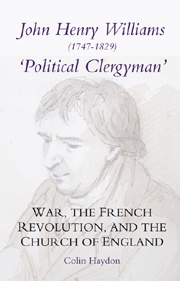 John Henry Williams (1747–1829): 'Political Clergyman'
John Henry Williams (1747–1829): 'Political Clergyman' Book contents
- Frontmatter
- Contents
- Dedication
- Illustrations
- Preface and Acknowledgements
- Abbreviations
- Editorial Note
- 1 The Grave and the Memory
- 2 The Formative Years
- 3 The Ivy-mantled Tow'r: Parish and Pastoralia
- 4 The Gathering Storm
- 5 By Far the Heaviest of All Earthly Calamities: Williams' Anti-War Sermons
- 6 Anxiety, the 1797 Campaign, and Afterwards
- 7 Assessment
- Bibliography
- Index
- STUDIES IN MODERN BRITISH RELIGIOUS HISTORY
6 - Anxiety, the 1797 Campaign, and Afterwards
Published online by Cambridge University Press: 12 September 2012
- Frontmatter
- Contents
- Dedication
- Illustrations
- Preface and Acknowledgements
- Abbreviations
- Editorial Note
- 1 The Grave and the Memory
- 2 The Formative Years
- 3 The Ivy-mantled Tow'r: Parish and Pastoralia
- 4 The Gathering Storm
- 5 By Far the Heaviest of All Earthly Calamities: Williams' Anti-War Sermons
- 6 Anxiety, the 1797 Campaign, and Afterwards
- 7 Assessment
- Bibliography
- Index
- STUDIES IN MODERN BRITISH RELIGIOUS HISTORY
Summary
The Tightening Net
From 1792, Crown, government, and Parliament sought to subdue radical politics in England.
In May 1792, George III issued a proclamation urging magistrates to suppress ‘seditious Writings’ and ‘all Riots, Tumults and other Disorders’. The government encouraged the authorities to prosecute radical authors and publishers and, in December, when it apparently thought an insurrection imminent, a second proclamation was issued, embodying the militia. In May 1794, Habeas Corpus was suspended, and, in the same month, the leading radicals Thomas Hardy, John Thelwall, and John Horne Tooke were charged with high treason – though they were subsequently acquitted. The next year, two key measures were enacted. First, the Treasonable and Seditious Practices Act defined treason as any ‘compassings, imaginations, inventions, devices, or intentions’, published or written, aiming to intimidate Parliament or ‘by force or constraint, to compel … ‘the King or his heirs’ to change his or their measures or counsels’. Secondly, the Seditious Meetings Act banned meetings of more than fifty people whose purpose was to petition Parliament regarding, or discuss changes to, the political and religious status quo. In 1798, the Newspaper Publication Act required the registration of printing presses, and, in 1799, an Act was passed for ‘the More Effective Suppression of Societies Established for Seditious and Treasonable Purposes’. Using secret service monies, the government subsidized the loyalist press, and, in 1792 and 1793, helped to launch two alarmist newspapers, The Sun and The True Briton.
- Type
- Chapter
- Information
- John Henry Williams (1747–1829): 'Political Clergyman'War, the French Revolution, and the Church of England, pp. 115 - 138Publisher: Boydell & BrewerPrint publication year: 2007


